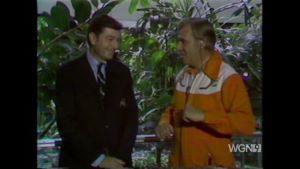Ark in the Park

If you grew up in Chicago many years ago, there was a daily morning television show called Ray Rayner and His Friends. It was sort of like Good Morning America with old Warner Brother cartoons, though depending what you think of the animated antics of the hosts and guests of national morning television, you could say they were exactly alike, though Ray's cartoon characters were more entertaining.
One recurring segment of the show was called, “Ark in the Park.” Ray would visit Doctor Lester Fisher, Director of the Lincoln Park Zoo, along with the ark's residents. Fisher died yesterday at 100. The “Ark in the Park,” obviously derived from the story of Noah, instead of a conservation vessel created against a raging deity's flood was a sanctuary for a few species from homo sapiens' ravaging of the biosphere.
Fisher helped lead the way trying to make these artificial habitats as interesting for their refugees as possible. Particularly, the zoo concentrated on ape conservation. Since then, I always wanted to see humanity's closest surviving relatives in their native habitats, but there's not many left. You have to get to pretty remote places. The only apes managing to hang on are as far from their human relatives as they can get.
I got pretty close to some gorillas in Nigeria. But it was another 4 or 5 hours of an already long trip to the area where they survived. My intrepid Nigerian companion didn't want to go. “That's history,” meaning the gorillas, he would reply each time I pushed. Fortunately, a few, very few, Cross River gorillas do indeed remain. Even if we had went there, chances are we would have never seen them. But it's good for the soul to know they're still hanging on.
Biodiversity, the preservation of species and their habitats, is one of those environmental issues that doesn’t get a lot of attention. Conservation, though the oldest environmental politics, remains the most radical. For our over stimulated ape brains, something can always be better than what's already there, especially if it doesn't yet have our fingerprints all over it.
We are learning the diversity of life is healthy for all life, most specifically for our lives. Yet, since the dawn of agriculture and then exponentially faster with industrialization, we have done just the opposite, quashing diversity and celebrating our own manufactured homogeneity, no greater example than our industrial agriculture system. There's a nice article in the FT about a farmer in England who is doing things differently. The farmer, James Rebanks, sums up the global problem,
“What you’re actually doing to almost every field in England is increasing the pressures which would make it less biodiverse, less sustainable. You’re asking it to compete with the most un-British landscapes on Earth, that do everything in monocultures and are highly specialised. There’s a complete nonsense to that,”
He then talks of his work trying to change this,
“The best way of feeding the ground, it turns out, is to let plants grow. Green plants photosynthesise, and pump masses of carbon and sugars through their own root systems into the ground. So, letting plants grow longer between grazings is a huge thing. The second one . . . that the soil scientists have now explained to us is, particularly in summer, trampling of as much of that green matter into the surface so it begins to rot and the worms turn it into humus soil,” he says, admitting he has become a soil geek.”
Soil degradation and erosion from industrial practices is another of those environmental problems that don't much make the news, and they are intricately tied to biodiversity.
Using a vocabulary that might make this all a little more understandable to homo capitalist, the bio-ledger is in great arrears, though in our debt is wealth era, that's probably not understood either. Changing all this is not about making electric cars, but a rethinking of how we do pretty much everything. The long term success of Dr. Fisher's ark depends on it.
Peace on Earth
Goodwill Toward Life

